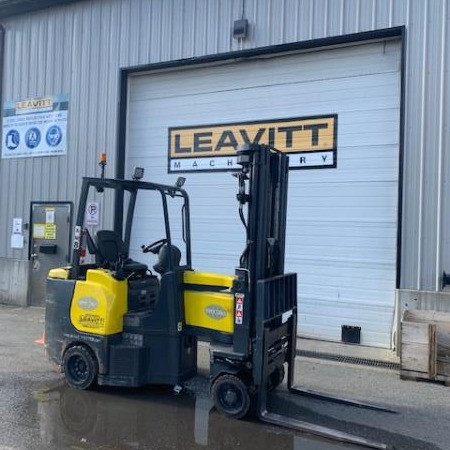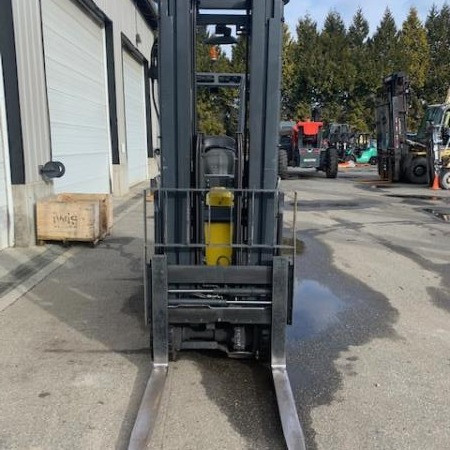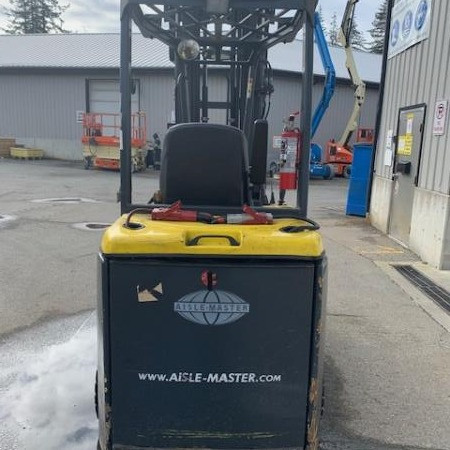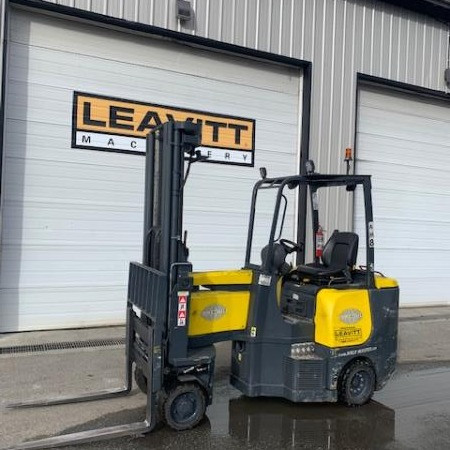Very Narrow Aisle Forklift Nebraska
Used Very Narrow Aisle Forklift Nebraska - Warehousing needs greatly focus on space-saving techniques and layout to maximize expensive square footage and decrease travel time needed to get goods from the loading docks and from point A to point B. Very narrow aisle solutions allow for more space to be dedicated to the storage of goods because less space is required for aisle access. Warehouse optimization consists of warehouse configurations.
Warehouse Optimization
Implementing very narrow aisle warehouse optimization is a huge benefit of warehouse optimization. One of the most important benefits is the increased storage space.
Because very narrow forklift trucks were developed to take up less space in maneuvering, it is now possible to decrease warehouse aisle width to less than half the width required by standard forklifts. Many very narrow aisle forklifts offer greater stack height capability which further increases the storage capacity per square foot. Costs can be drastically decreased with a narrow aisle forklift compared to a standard aisle configuration as less warehouse space is required for the same quantity of stock. Most urban locations have expensive square footage; therefore, reducing costs is a benefit to warehouses and their business. Adding a very narrow aisle width system can increase storage up to eighty percent when planned properly. This warehouse design creates more rack faces and increased product access. This usually equates to less travel time gathering and storing product as more product is located within a smaller, more accessible area.
Warehouse layouts usually utilize a narrow aisle or very narrow aisle plan. Less than eleven feet of aisle width is needed by narrow aisles. Very narrow aisles reduce the aisle width further to around six-and-a-half feet. Storage options are greatly increased with these aisle width options. However, they also create challenges when turning within the aisles using forklifts for stocking and order picking. These challenges are met by using very narrow forklifts to gain access and complete tasks.
Before choosing a forklift for a particular job, it is vital to know the dimensions of the aisle. It is important to have the correct aisle dimensions before forklift shopping to avoid securing a machine that won’t fit its’ intended location. It is essential to take any columns, posts or utilities into account before deciding a type of narrow aisle forklift design as these can block access.
Very Narrow Aisle Forklift Trucks
Very narrow aisle forklift trucks are almost always powered electrically, usually by rechargeable battery. These very narrow aisle trucks are more commonly available as stand-up riders, which helps increase productivity and operator comfort. There are different very narrow aisle forklift designs such as order pickers, reach trucks, wing-mast or turret and end-control riders.
Reach Forklift Trucks
The reach trucks were created as a type of rider stacker forklift but can be modified specifically for narrow aisle usage. This machine earned its name by its ability to reach its forks to secure a load. The moving mast and the moving carriage are two types of reach trucks. The moving carriage functions by lowering and raising the carriage and the operator. While the operator stays at ground level, the moving mast is responsible for raising and lowering the forks. The moving reach truck is typically considered the safest out of the two kinds of reach trucks. Reach trucks utilize a pantograph system that is a jointed framework design enabling the driver to place and reach loads without moving the forklift.
Order Pickers
Order pickers were created to specifically pick orders from difficult-to-access racks. Order pickers are specific for lighter stock items that can be lifted by hand. They lift the operator up to reach the goods by identifying and choosing certain items to create an order.
End-Control Riders
End-control riders are machines that pick loads up at floor level and move the items horizontally as opposed to lowering or lifting over numerous heights.
Turret or Swing-Mast Forklift
The turret or swing mast very narrow aisle forklifts have a swivel mast that pivots and articulates. Pallets can be set on either the right or left side of the forklift due to the machine’s ability to use its’ swinging mast.
Guided Very Narrow Aisle Trucks
Rail or wire can guide the very narrow aisle forklift trucks down the aisle securely.
Thanks to the guide rails, the possibility of crashing into racks is greatly reduced. In rail-guided models, sets of rails are placed into the floor on each side of the aisle. They run the length of the aisle and also curve around the aisles’ edge. The forklift is fitted with special wheel guides that slide into the rails, preventing the forklift from moving outside the rail guards.
Running down the center of the aisle, wire-guidance forklifts rely on floor wires instead of rails. Narrow aisle forklifts rely on a wire-guide system to help it communicate with the floor wires. This allows the machine to be steered by the wires, stopping it from traveling outside of the specific location.
Work Site Considerations
Certain essential considerations need to be dealt with before using a narrow aisle configuration. The floor and the rack construction needs to be evaluated to avoid any issues since the very narrow aisle units have extremely high racking systems. There are four main locations that need to be ideally prepared before any racking system can be installed. These areas need to be monitored continuously including fixing cracks in the floor, ensuring the racks are straight, a level floor and an appropriate load capacity of the floor.
Level Floor
Because of the height of the racking systems, any slight slope of the floor is likely to negatively affect the plumbness of the racks, especially over time when loads are continuously placed and removed on the racks. Without a level floor foundation, the rack stability could be compromised.
Crack Repair
When there are floor cracks found, they need to be assessed and immediately fixed for safety concerns. Cracks may affect the floor’s level and, when they are approximately 3/8 inches wide, will need to be properly filled with a material at least as hard as the surrounding floor.
Floor Load Capacity
The floor should meet certain minimum requirements before considering a narrow aisle configuration. Minimum flooring requirements include concrete measuring three thousand psi and rebar distributed evenly three to four inches below the surface. Extra reinforcements might be needed depending on the load requirements and the configuration.
Plumb Racks
Installing the racks safely and correctly is vital for the entire system. Rack failure can happen if they are improperly installed. One of the most important details to ensure proper installation, is that all racks are plumb. If necessary, rack shims should be used to ensure the racks are plumb within 1 inch at the 30 foot height of the racks.
Racking failure can happen if the aforementioned measures are not taken or implemented correctly. Employees can become hurt or killed in the event that racking failure occurs. Goods can be damaged along with forklifts and other equipment. These measurements are vital to the success of installing a safe and productive narrow aisle configuration.
Very Narrow Aisle Forklift PDF
Stock Number: 209213 GL
Make: AISLEMASTER
Model: 44SE
Year: 2015
| Stock Number |
209213 GL |
| Make |
AISLEMASTER |
| Model |
44SE |
| Year |
2015 |
| Category |
Very Narrow Aisle Forklift |
Stock Number: 207213 GL
Make: AISLEMASTER
Model: 44E
Year: 2013
| Stock Number |
207213 GL |
| Make |
AISLEMASTER |
| Model |
44E |
| Year |
2013 |
| Category |
Very Narrow Aisle Forklift |
Stock Number: 208758 GL
Make: AISLEMASTER
Model: 44SE
Year: 2015
| Stock Number |
208758 GL |
| Make |
AISLEMASTER |
| Model |
44SE |
| Year |
2015 |
| Category |
Very Narrow Aisle Forklift |













